warning YAMAHA MT-07 2014 User Guide
[x] Cancel search | Manufacturer: YAMAHA, Model Year: 2014, Model line: MT-07, Model: YAMAHA MT-07 2014Pages: 106, PDF Size: 3.29 MB
Page 23 of 106
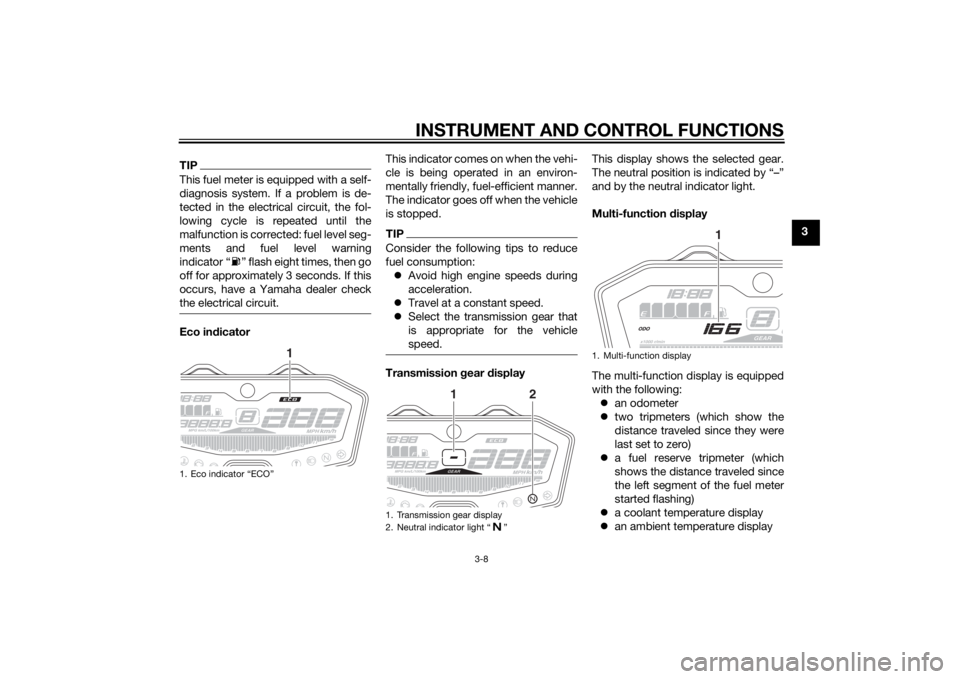
INSTRUMENT AND CONTROL FUNCTIONS
3-8
3
TIPThis fuel meter is equipped with a self-
diagnosis system. If a problem is de-
tected in the electrical circuit, the fol-
lowing cycle is repeated until the
malfunction is corrected: fuel level seg-
ments and fuel level warning
indicator “ ” flash eight times, then go
off for approximately 3 seconds. If this
occurs, have a Yamaha dealer check
the electrical circuit.Eco indicator This indicator comes on when the vehi-
cle is being operated in an environ-
mentally friendly, fuel-efficient manner.
The indicator goes off when the vehicle
is stopped.
TIPConsider the following tips to reduce
fuel consumption:
Avoid high engine speeds during
acceleration.
Travel at a constant speed.
Select the transmission gear that
is appropriate for the vehicle
speed.Transmission gear display This display shows the selected gear.
The neutral position is indicated by “–”
and by the neutral indicator light.
Multi-function
display
The multi-function display is equipped
with the following: an odometer
two tripmeters (which show the
distance traveled since they were
last set to zero)
a fuel reserve tripmeter (which
shows the distance traveled since
the left segment of the fuel meter
started flashing)
a coolant temperature display
an ambient temperature display
1. Eco indicator “ECO”
1
1. Transmission gear display
2. Neutral indicator light “ ”
1
2
1. Multi-function display
1
U1WSE0E0.book Page 8 Wednesday, November 13, 2013 10:28 AM
Page 24 of 106

INSTRUMENT AND CONTROL FUNCTIONS
3-9
3
an instantaneous fuel consump-
tion display
an average fuel consumption dis-
play
Push the left set button to switch the
display between the odometer mode
“ODO”, tripmeter modes “TRIP 1” and
“TRIP 2”, instantaneous fuel consump-
tion mode “km/L” or “L/100 km”, aver-
age fuel consumption mode “AVE_ _._
km/L” or “AVE_ _._ L/100 km”, coolant
temperature mode “_ _ °C”, and ambi-
ent temperature mode “Air_ _ °C” in
the following order:
ODO → TRIP 1 → TRIP 2 →km/L or
L/100 km → AVE_ _._ km/L or AVE_ _._
L/100 km → _ _ °C → Air_ _ °C → ODO
For the UK only:
Push the left set button to switch the
display between the odometer mode
“ODO”, tripmeter modes “TRIP 1” and
“TRIP 2”, instantaneous fuel consump-
tion mode “km/L”, “L/100 km” or
“MPG”, average fuel consumption
mode “AVE_ _._ km/L”, “AVE_ _._
L/100 km” or “AVE_ _._ MPG”, coolant temperature mode “_ _ °C”, and ambi-
ent temperature mode “Air_ _ °C” in
the following order:
ODO
→ TRIP 1 → TRIP 2 → km/L,
L/100 km or MPG → AVE_ _._ km/L,
AVE_ _._ L/100 km or AVE_ _._ MPG →
_ _ °C → Air_ _ °C → ODO
TIPPush the right set button to switch the
display in the reverse order.If the fuel level warning indicator “ ”
and left segment of the fuel meter start
flashing, the display automatically
changes to the fuel reserve tripmeter
mode “TRIP F” and starts counting the
distance traveled from that point. In
that case, push the left set button to
switch the display between the various
tripmeter, odometer, instantaneous
fuel consumption and average fuel
consumption modes in the following
order: TRIP F
→ km/L or L/100 km → AVE_
_._ km/L or AVE_ _._ L/100 km → _ _
°C → Air_ _ °C → ODO → TRIP 1 →
TRIP 2 → TRIP F
For the UK only:
TRIP F → km/L, L/100 km or MPG →
AVE_ _._ km/L, AVE_ _._ L/100 km or
AVE_ _._ MPG → _ _ °C → Air_ _ °C →
ODO → TRIP 1 → TRIP 2 → TRIP F
To reset a tripmeter, select it by push-
ing the left set button, and then push
the right set button for at least one sec-
ond.
If you do not reset the fuel reserve trip-
meter manually, it resets itself auto-
matically and the display returns to the
prior mode after refueling and traveling
5 km (3 mi).
U1WSE0E0.book Page 9 Wednesday, November 13, 2013 10:28 AM
Page 26 of 106
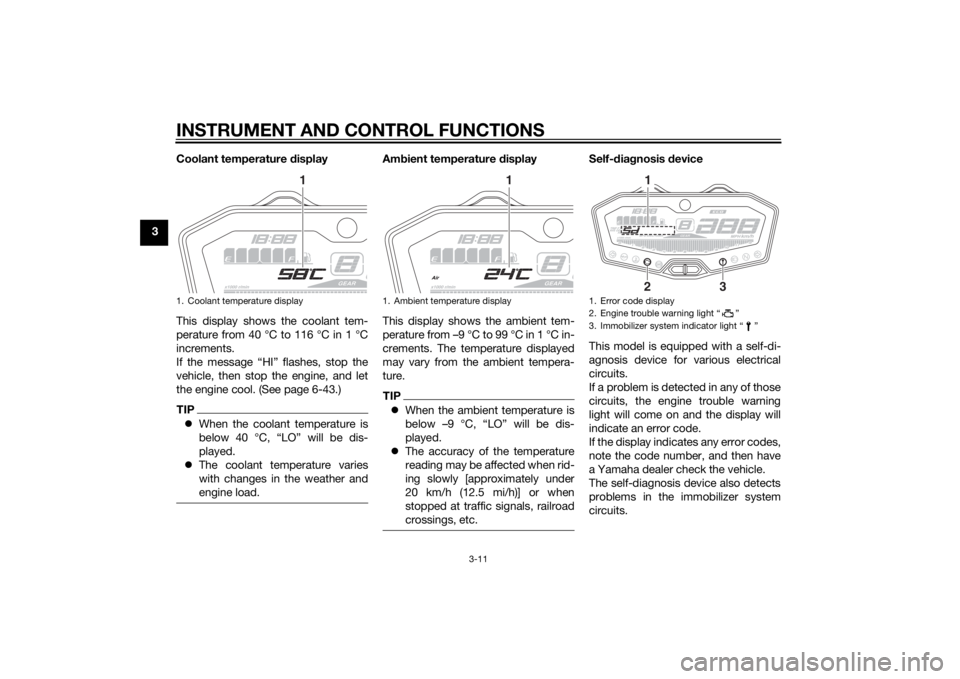
INSTRUMENT AND CONTROL FUNCTIONS
3-11
3Coolant temperature
display
This display shows the coolant tem-
perature from 40 °C to 116 °C in 1 °C
increments.
If the message “HI” flashes, stop the
vehicle, then stop the engine, and let
the engine cool. (See page 6-43.)
TIP When the coolant temperature is
below 40 °C, “LO” will be dis-
played.
The coolant temperature varies
with changes in the weather and
engine load.
Am bient temperature display
This display shows the ambient tem-
perature from –9 °C to 99 °C in 1 °C in-
crements. The temperature displayed
may vary from the ambient tempera-
ture.TIP When the ambient temperature is
below –9 °C, “LO” will be dis-
played.
The accuracy of the temperature
reading may be affected when rid-
ing slowly [approximately under
20 km/h (12.5 mi/h)] or when
stopped at traffic signals, railroad
crossings, etc.
Self-d iagnosis device
This model is equipped with a self-di-
agnosis device for various electrical
circuits.
If a problem is detected in any of those
circuits, the engine trouble warning
light will come on and the display will
indicate an error code.
If the display indicates any error codes,
note the code number, and then have
a Yamaha dealer check the vehicle.
The self-diagnosis device also detects
problems in the immobilizer system
circuits.
1. Coolant temperature display
1
1. Ambient temperature display
1
1. Error code display
2. Engine trouble warning light “ ”
3. Immobilizer system indicator light “ ”
21
3
U1WSE0E0.book Page 11 Wednesday, November 13, 2013 10:28 AM
Page 28 of 106
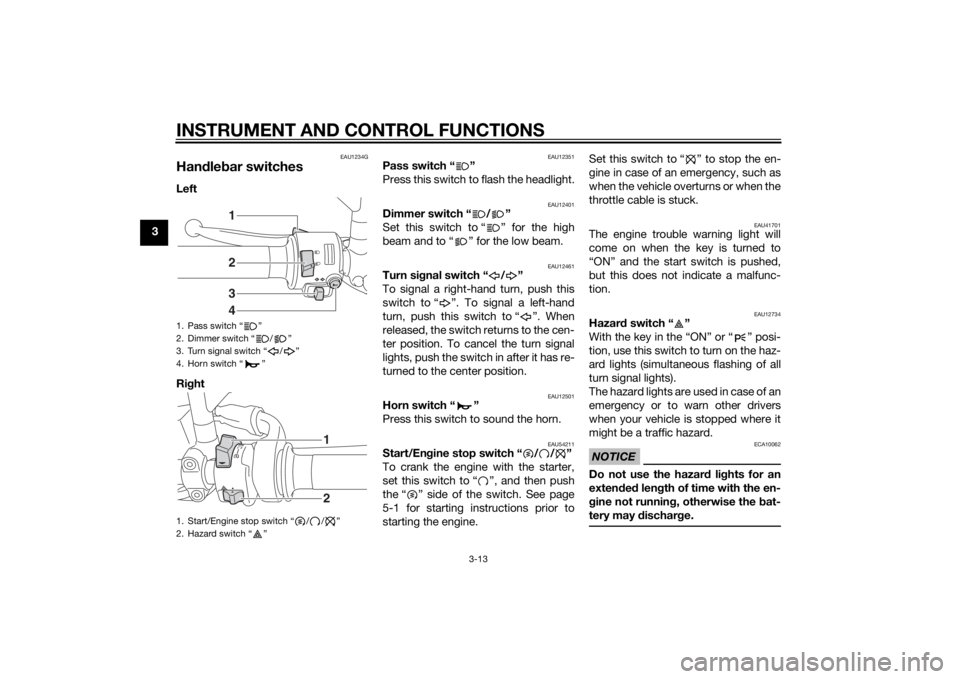
INSTRUMENT AND CONTROL FUNCTIONS
3-13
3
EAU1234G
Handle bar switchesLeft
Ri ght
EAU12351
Pass switch “ ”
Press this switch to flash the headlight.
EAU12401
Dimmer switch “ / ”
Set this switch to “ ” for the high
beam and to “ ” for the low beam.
EAU12461
Turn si gnal switch “ / ”
To signal a right-hand turn, push this
switch to “ ”. To signal a left-hand
turn, push this switch to “ ”. When
released, the switch returns to the cen-
ter position. To cancel the turn signal
lights, push the switch in after it has re-
turned to the center position.
EAU12501
Horn switch “ ”
Press this switch to sound the horn.
EAU54211
Start/En gine stop switch “ / / ”
To crank the engine with the starter,
set this switch to “ ”, and then push
the “ ” side of the switch. See page
5-1 for starting instructions prior to
starting the engine. Set this switch to “ ” to stop the en-
gine in case of an emergency, such as
when the vehicle overturns or when the
throttle cable is stuck.
EAU41701
The engine trouble warning light will
come on when the key is turned to
“ON” and the start switch is pushed,
but this does not indicate a malfunc-
tion.
EAU12734
Hazar
d switch “ ”
With the key in the “ON” or “ ” posi-
tion, use this switch to turn on the haz-
ard lights (simultaneous flashing of all
turn signal lights).
The hazard lights are used in case of an
emergency or to warn other drivers
when your vehicle is stopped where it
might be a traffic hazard.NOTICE
ECA10062
Do not use the hazard lights for an
exten ded len gth of time with the en-
g ine not runnin g, otherwise the bat-
tery may dischar ge.
1. Pass switch “ ”
2. Dimmer switch “ / ”
3. Turn signal switch “ / ”
4. Horn switch “ ”
1. Start/Engine stop switch “ / / ”
2. Hazard switch “ ”
2341
12
U1WSE0E0.book Page 13 Wednesday, November 13, 2013 10:28 AM
Page 30 of 106

INSTRUMENT AND CONTROL FUNCTIONS
3-15
3
EAU12942
Brake pedalThe brake pedal is on the right side of
the motorcycle. To apply the rear
brake, press down on the brake pedal.
EAU60020
ABS (for ABS mo dels)The Yamaha ABS (Anti-lock Brake
System) features a dual electronic con-
trol system, which acts on the front and
rear brakes independently.
Operate the brakes with ABS as you
would conventional brakes. If the ABS
is activated, a pulsating sensation may
be felt at the brake lever or brake ped-
al. In this situation, continue to apply
the brakes and let the ABS work; do
not “pump” the brakes as this will re-
duce braking effectiveness.
WARNING
EWA16051
Always keep a sufficient distance
from the vehicle ahea d to match the
ri din g spee d even with ABS.
The ABS performs best with
lon g b rakin g d istances.
On certain surfaces, such as
rou gh or g ravel roa ds, the b rak-
in g d istance may b e longer with
the ABS than without.The ABS is monitored by an ECU,
which will revert the system to conven-
tional braking if a malfunction occurs.
TIP The ABS performs a self-diagno-
sis test each time the vehicle first
starts off after the key is turned to
“ON” and the vehicle has traveled
at a speed of 10 km/h (6 mi/h) or
higher. During this test, a “click-
ing” noise can be heard from the
hydraulic control unit, and if the
brake lever or brake pedal is even
slightly applied, a vibration can be
felt at the lever and pedal, but
these do not indicate a malfunc-
tion.
This ABS has a test mode which
allows the owner to experience
the pulsation at the brake lever or
brake pedal when the ABS is op-
erating. However, special tools are
required, so please consult your
Yamaha dealer when performing
this test.
1. Brake pedal
1
U1WSE0E0.book Page 15 Wednesday, November 13, 2013 10:28 AM
Page 32 of 106
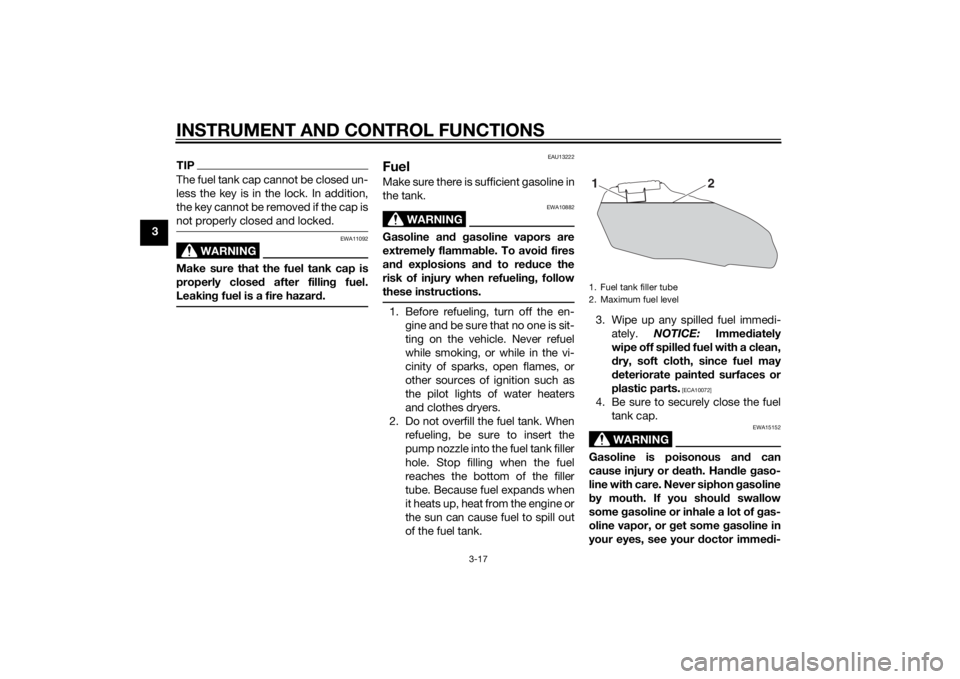
INSTRUMENT AND CONTROL FUNCTIONS
3-17
3
TIPThe fuel tank cap cannot be closed un-
less the key is in the lock. In addition,
the key cannot be removed if the cap is
not properly closed and locked.
WARNING
EWA11092
Make sure that the fuel tank cap is
properly closed after fillin g fuel.
Leakin g fuel is a fire hazar d.
EAU13222
FuelMake sure there is sufficient gasoline in
the tank.
WARNING
EWA10882
Gasoline an d g asoline vapors are
extremely flamma ble. To avoi d fires
an d explosions an d to re duce the
risk of injury when refuelin g, follow
these instructions.1. Before refueling, turn off the en- gine and be sure that no one is sit-
ting on the vehicle. Never refuel
while smoking, or while in the vi-
cinity of sparks, open flames, or
other sources of ignition such as
the pilot lights of water heaters
and clothes dryers.
2. Do not overfill the fuel tank. When refueling, be sure to insert the
pump nozzle into the fuel tank filler
hole. Stop filling when the fuel
reaches the bottom of the filler
tube. Because fuel expands when
it heats up, heat from the engine or
the sun can cause fuel to spill out
of the fuel tank. 3. Wipe up any spilled fuel immedi-
ately. NOTICE: Immediately
wipe off spille d fuel with a clean,
d ry, soft cloth, since fuel may
d eteriorate painted surfaces or
plastic parts.
[ECA10072]
4. Be sure to securely close the fuel tank cap.
WARNING
EWA15152
Gasoline is poisonous an d can
cause injury or death. Han dle gaso-
line with care. Never siphon gasoline
b y mouth. If you shoul d swallow
some gasoline or inhale a lot of g as-
oline vapor, or g et some gasoline in
your eyes, see your doctor imme di-1. Fuel tank filler tube
2. Maximum fuel level
2
1
U1WSE0E0.book Page 17 Wednesday, November 13, 2013 10:28 AM
Page 34 of 106

INSTRUMENT AND CONTROL FUNCTIONS
3-19
3
EAU13434
Catalytic converterThis model is equipped with a catalytic
converter in the exhaust system.
WARNING
EWA10863
The exhaust system is hot after op-
eration. To prevent a fire hazard or
b urns:
Do not park the vehicle near
possi ble fire hazard s such as
g rass or other materials that
easily burn.
Park the vehicle in a place
where ped estrians or chil dren
are not likely to touch the hot
exhaust system.
Make sure that the exhaust sys-
tem has cooled down before
d oin g any maintenance work.
Do not allow the en gine to i dle
more than a few minutes. Lon g
i d lin g can cause a b uild-up of
heat.
NOTICE
ECA10702
Use only unlea ded g asoline. The use
of lead ed g asoline will cause unre-
pairab le dama ge to the catalytic
converter.
EAU59901
SeatsPassen ger seat
To remove the passenger seat1. Insert the key into the seat lock, and then turn it counterclockwise.
2. While holding the key in that posi- tion, lift the rear of the passenger
seat and pull it backward.1. Seat lock
2. Unlock.
1
2
U1WSE0E0.book Page 19 Wednesday, November 13, 2013 10:28 AM
Page 36 of 106
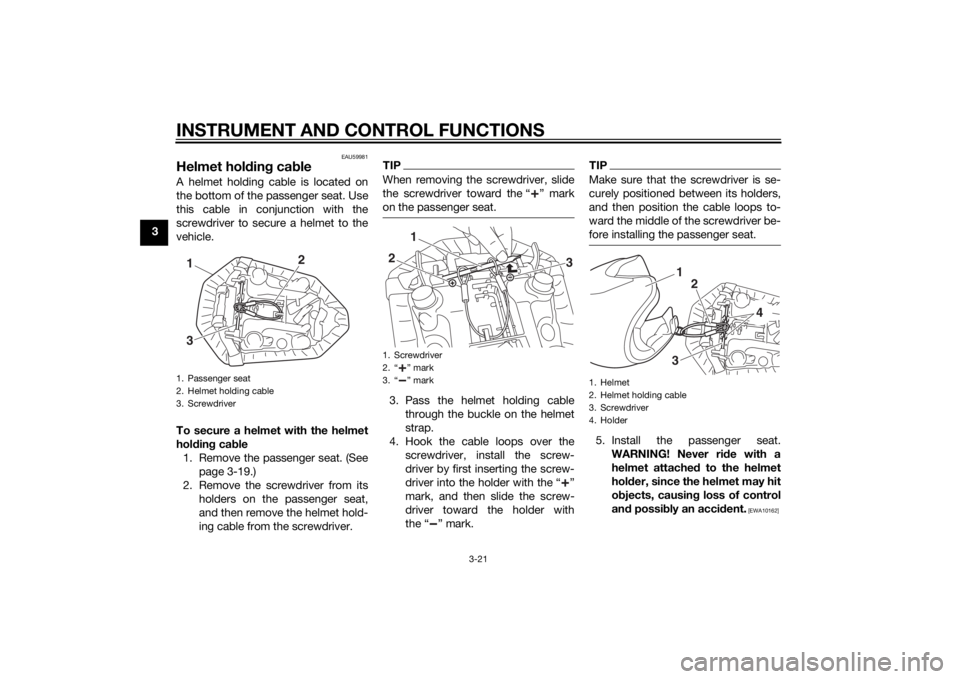
INSTRUMENT AND CONTROL FUNCTIONS
3-21
3
EAU59981
Helmet holdin g ca bleA helmet holding cable is located on
the bottom of the passenger seat. Use
this cable in conjunction with the
screwdriver to secure a helmet to the
vehicle.
To secure a helmet with the helmet
hol din g cab le
1. Remove the passenger seat. (See page 3-19.)
2. Remove the screwdriver from its holders on the passenger seat,
and then remove the helmet hold-
ing cable from the screwdriver.
TIPWhen removing the screwdriver, slide
the screwdriver toward the “ ” mark
on the passenger seat.3. Pass the helmet holding cablethrough the buckle on the helmet
strap.
4. Hook the cable loops over the screwdriver, install the screw-
driver by first inserting the screw-
driver into the holder with the “ ”
mark, and then slide the screw-
driver toward the holder with
the “ ” mark.
TIPMake sure that the screwdriver is se-
curely positioned between its holders,
and then position the cable loops to-
ward the middle of the screwdriver be-
fore installing the passenger seat.5. Install the passenger seat.WARNING! Never ri de with a
helmet attached to the helmet
hol der, since the helmet may hit
o bjects, causin g loss of control
an d possi bly an acci dent.
[EWA10162]
1. Passenger seat
2. Helmet holding cable
3. Screwdriver1
2
3
1. Screwdriver
2. “ ” mark
3. “ ” mark
1
2
3
1. Helmet
2. Helmet holding cable
3. Screwdriver
4. Holder
1
2
3
4
U1WSE0E0.book Page 21 Wednesday, November 13, 2013 10:28 AM
Page 37 of 106

INSTRUMENT AND CONTROL FUNCTIONS
3-22
3
To release a helmet from the helmet
hol
din g cab le
1. Remove the passenger seat.
2. Remove the screwdriver, then re- move the helmet holding cable
from the helmet.
3. Store the cable under the seat by hooking the cable loops over the
screwdriver, install the screw-
driver in its original position, and
then hook the helmet holding ca-
ble over the hook on the bottom of
the passenger seat.
4. Install the passenger seat.
EAU14465
Stora ge compartmentThe storage compartment is located
under the passenger seat. (See page
3-19.)
When storing documents or other
items in the storage compartment, be
sure to wrap them in a plastic bag so
that they will not get wet. When wash-
ing the vehicle, be careful not to let any
water enter the storage compartment.
WARNING
EWA10962
Do not exceed the load limit of
1.5 k g (3 l b) for the stora ge com-
partment.
Do not excee d the maximum
loa d of MT07 176 k g (388 l b)
MT07A 173 k g (381 l b) for the ve-
hicle.
1. Screwdriver
2. Helmet holding cable
3. Hook1
2
3
1. Storage compartment
1
U1WSE0E0.book Page 22 Wednesday, November 13, 2013 10:28 AM
Page 38 of 106
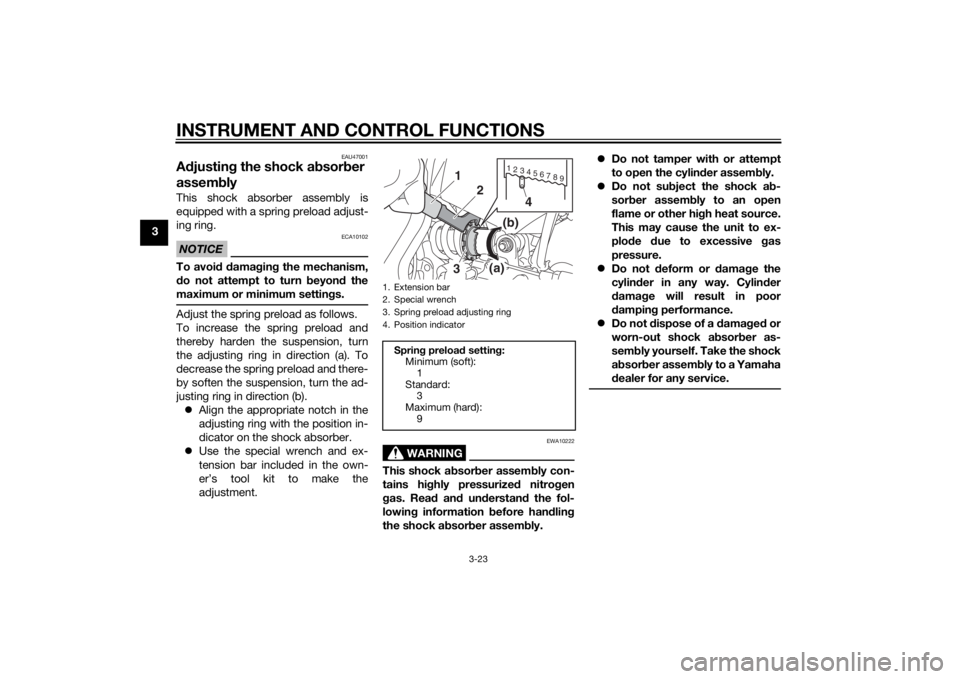
INSTRUMENT AND CONTROL FUNCTIONS
3-23
3
EAU47001
Adjusting the shock absorber
assemblyThis shock absorber assembly is
equipped with a spring preload adjust-
ing ring.NOTICE
ECA10102
To avoid damaging the mechanism,
do not attempt to turn beyond the
maximum or minimum settings.Adjust the spring preload as follows.
To increase the spring preload and
thereby harden the suspension, turn
the adjusting ring in direction (a). To
decrease the spring preload and there-
by soften the suspension, turn the ad-
justing ring in direction (b). Align the appropriate notch in the
adjusting ring with the position in-
dicator on the shock absorber.
Use the special wrench and ex-
tension bar included in the own-
er’s tool kit to make the
adjustment.
WARNING
EWA10222
This shock absorber assembly con-
tains highly pressurized nitrogen
gas. Read and understand the fol-
lowing information before handling
the shock absorber assembly.
Do not tamper with or attempt
to open the cylinder assembly.
Do not subject the shock ab-
sorber assembly to an open
flame or other high heat source.
This may cause the unit to ex-
plode due to excessive gas
pressure.
Do not deform or damage the
cylinder in any way. Cylinder
damage will result in poor
damping performance.
Do not dispose of a damaged or
worn-out shock absorber as-
sembly yourself. Take the shock
absorber assembly to a Yamaha
dealer for any service.1. Extension bar
2. Special wrench
3. Spring preload adjusting ring
4. Position indicatorSpring preload setting:
Minimum (soft):1
Standard: 3
Maximum (hard):
9
7
6
9
8
5
4
3
2
1
3
(a)(b)
2
1
4
U1WSE0E0.book Page 23 Monday, May 26, 2014 1:11 PM